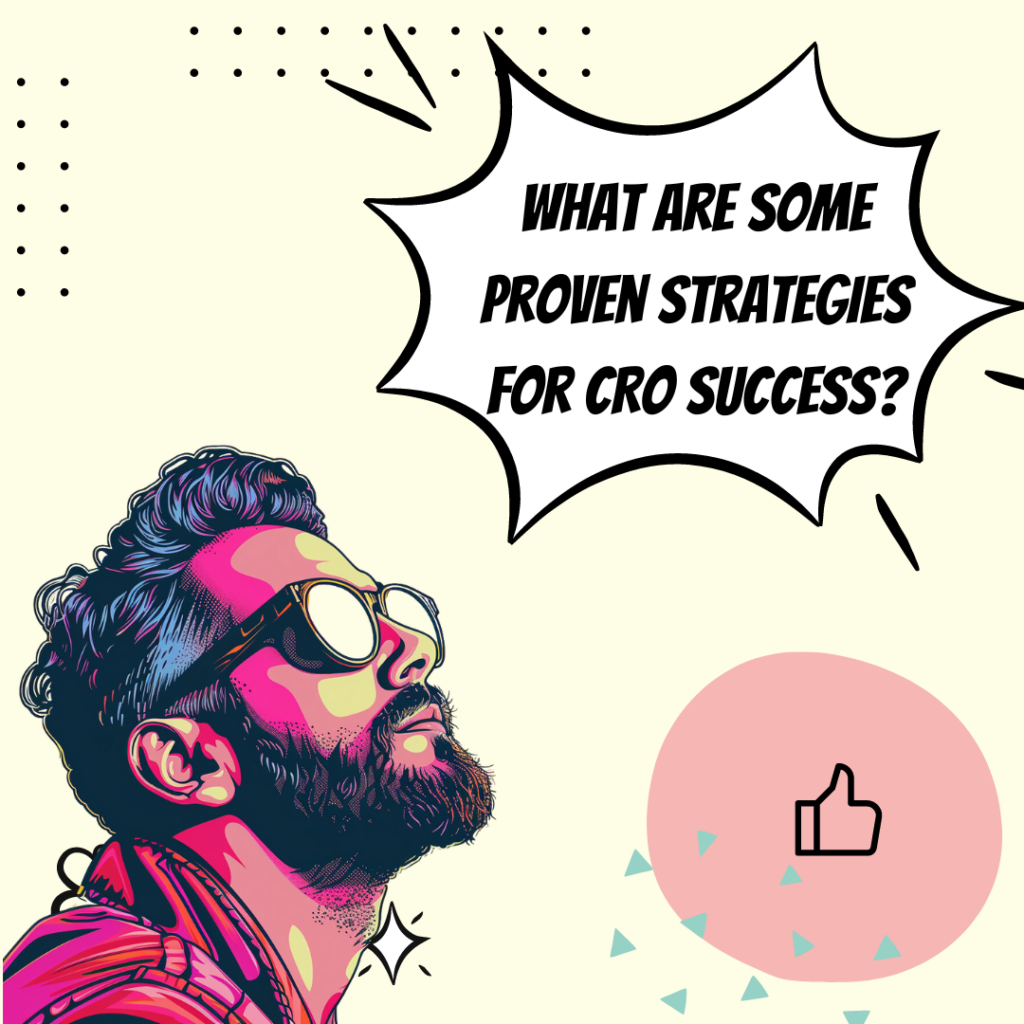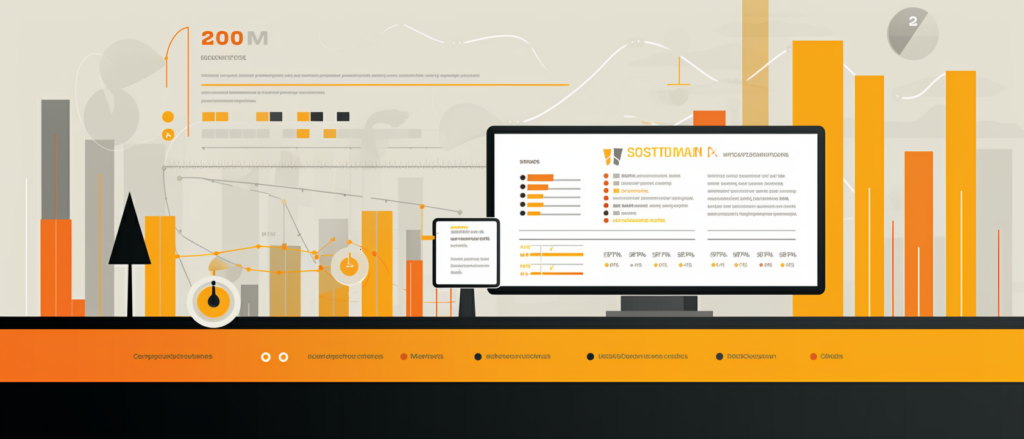Key Takeaways
✅ Precise Conversion Metrics: Dive into specific KPIs like click-through rates and conversion rates to gauge your split tests' success. Don't let premature changes or a lack of statistical significance undermine your results.
✅ Proven CRO Strategies: Embrace a cycle of continuous improvement. Stick to testing one variable at a time for clarity and refine your marketing approach for better-targeted outcomes.
✅ Achieving Higher Conversions: Harness the power of A/B testing for actionable insights, fine-tuning your strategies to enhance user experience and conversion rates.

Introduction
Are you keen on turning those website visits into a flood of conversions? Then you're in the right place. The quest for higher conversion rates can sometimes feel like searching for treasure without a map. But what if you could pinpoint exactly what enchants your audience and compels them to act? Achieve Higher Conversions with Split Testing: this isn't just a fancy phrase, it's your golden ticket to maximize returns.
Understanding Split Testing is fundamental, and here, you're about to peel back the layers of this indispensable tool. Imagine you could tweak your digital presence in real-time, learning from each visitor's click and scroll. Truth be told, this isn't wishful thinking—it's the strategic power of split testing, and it's ripe for the picking.
Join us as we venture beyond the bare bones of best practices. Together, we'll explore modern trends and solutions, all aimed at boosting your revenue and ROI. By the end of this journey, you'll have a treasure trove of actionable insights that could very well break open the floodgates to greater online success. Get ready to leave behind guesswork and embrace precision. Your map to richer conversions awaits!
Top Statistics
| Statistic | Insight |
|---|---|
| A/B testing can increase conversion rates by 28% | A substantial lift for any business, highlighting the sheer power of small tweaks. |
| 80.92% of all tests run are A/B tests | The large majority of tests signals a strong trust in A/B testing as an optimization method. |
| 50% conversion rate boost by cutting form fields from 4 to 3 | Less is more; streamlining user input could be an easy win for businesses. |
| Only 20% of experiments reach 95% statistical significance | Patient testing leads to certainty and confidence in results. |
| Creating archives of past CRO tests is a practice for over 40% | Looking back to learn; a treasure trove of insights for future decisions. |
Achieve Higher Conversions with Split Testing
Have you ever wondered if a different headline or a new color for your call-to-action button could make a difference in your sales? Well, split testing could be the answer to your curiosity. In the realm of digital marketing, split testing, also called A/B testing, is a method that pits two versions of a webpage or marketing material against each other to see which one performs better. At its core, you have a control group, a variation, and specific metrics like conversion rate or click-through rate. The beauty of split testing lies in its ability to fine-tune your marketing efforts, yielding more leads and creating a more engaging experience for your visitors.
Setting Up a Split Test
When carrying out a split test, the first step is to identify your goal: decide on the main result you're after, which usually revolves around enhancing a specific metric such as conversion rate. You'll need to start with a clear hypothesis about what change will cause an improvement. Once you know what you're aiming for, you create two versions: the control and the variation. The control is the original, and the variation is the newbie on the block.
Now here's a crucial part – scheduling your test. Timing is everything; both versions need to run over the same period to avoid skewed results. Also, it's wise not to conduct tests during irregular shopping periods or holidays, as these can affect user behavior.
Best Practices for Split Testing
The mantra for split testing is to keep tests simple. Try changing one element at a time to understand precisely what's affecting the outcomes. If you juggle too many variables, you'll end up not knowing which change made the difference. And remember, patience is a virtue. Tests should run long enough to gather meaningful data; cutting it short won't do you any favors.
Now, avoiding common pitfalls is just as important as following best practices. Don't be tempted to tweak the test once it's underway, and don't jump the gun on your results – wait for statistical significance. One of the most crucial steps is to document and share insights. Not only does it provide a reference for future tests, it also promotes a culture of learning and improvement within your team.
Precise Conversion Metrics
When you're diving into split testing, understanding and tracking the right conversion metrics is like finding the north star. Traffic tells you how many eyes are seeing your page, but Click Through Rate (CTR) goes a step further, shedding light on whether your content is hitting the mark with users. While clicks paint a picture of initial interest, it's the conversions that reveal if your digital presence is persuading visitors to take action. And let's not overlook impressions – these help you gauge if your content is even in the running to capture user interest.
Proven CRO Strategies
Your conversion rate is precious, and enhancing it requires a mix of understanding your audience and meticulous testing. To get ahead, offering personalized experiences can be a game-changer. But before you revamp your entire site or campaign, consider reducing risk by testing new elements in a controlled manner.
Best practices involve iterative improvements; it's like sculpting a masterpiece, bit by bit. Even minor tweaks can lead to a significantly better user experience and higher conversions. When it's time for a major change, full website testing can illuminate the strengths and weaknesses of a new design compared to the old.
Measuring and Analyzing Results
The real power of split testing begins to shine when looking at the data. Accurate and reliable data is the bedrock for making informed decisions for future strategies. It's not just about running tests; the analyzing part is what really matters. With each test, ensure you're documenting and sharing insights – doing so can transform insights into action. The cycle of testing, measuring, learning, and refining never really stops. But with every iteration, your marketing efforts should become sharper, smarter, and more effective—leading to that ever-coveted increase in conversions.
AI Marketing Engineers Recommendation
Recommendation 1: Harness Data to Personalize Experiences: Utilize data analytics to create personalized user experiences. According to a recent Epsilon study, 80% of consumers are more likely to make a purchase when brands offer personalized experiences. By engaging in Achieve Higher Conversions with Split Testing, tailor content, product recommendations, and offers to align with individual user behaviors and preferences. Implement tools that track user interactions to identify patterns, allowing you to split test variations that resonate more strongly with different segments. This can lead to a significant uptick in conversions.
Recommendation 2: Leverage AI for Predictive Analysis: Adopt AI-driven tools for predictive analysis to forecast future trends and consumer behavior. Current trends indicate that predictive analytics can improve conversions by up to 15%. By applying AI to your split testing and Precise Conversion Metrics, you are able to predict the success of various strategies before fully implementing them. This strategic insight can help optimize your CRO (Conversion Rate Optimization) efforts by focusing on changes that are more likely to yield positive results.
Recommendation 3: Utilize Comprehensive CRO Platforms: Integrate a comprehensive CRO platform that encompasses A/B testing, heatmaps, and user feedback tools. Platforms like Optimizely and Hotjar offer insights into how users interact with your site, providing an edge in creating Proven CRO Strategies. These tools offer direct evidence of what functions are working and what aren't, enabling you to make data-backed decisions to refine user journeys and improve conversion paths. The relevance of such platforms is backed by their prevalence; for instance, companies that use A/B testing are 50% more likely to report substantial conversion rate gains.
Relevant Links
- Maximize Conversion Rates with Effective Split Testing Techniques
- Unlocking the Potential of A/B Testing for Improved ROI
- Split Testing Secrets: Boost Your Digital Marketing Strategy
- Enhance User Engagement with Split Test Insights
- Leverage Split Testing to Revolutionize Your Online Sales
Conclusion
To boost your numbers and make the most out of every visitor that stumbles upon your website or marketing asset, embracing a culture that prioritizes split testing is essential. By thoroughly understanding what split testing involves and carefully setting up a structured and controlled environment, you can reveal invaluable data that can transform a hunch about customer behavior into a roadmap for your future marketing strategies.
Remember, improvements in conversion rates don't just come from major overhauls. Often, they're the result of meticulous attention to detail and the willingness to make incremental changes based on precise conversion metrics. By combining these minute yet significant amendments with proven CRO strategies, you create a synergistic effect that can massively amplify your success.
One question to ponder: What potential split tests have you been contemplating, and how might they alter the digital landscape of your business? By documenting every test and sharing the findings with your team, you ensure that every corner of your organization learns and grows from each experiment. After all, the data you collect isn't just numbers; it's a story about what your users prefer, how they behave, and what makes them click. So dive deep into split testing, equip yourself with the right conversion metrics, and embrace the continual cycle of testing, measuring, and refining. Let the quest for higher conversions be an ongoing journey, not a destination.
FAQs
Question 1: What is Split Testing?
Answer: Think of split testing, or A/B testing as it's also called, as a showdown between two versions of your webpage. It's all about figuring out which version gets more people to take action, like buying your stuff or signing up for your newsletter.
Question 2: What is Conversion Rate Optimization (CRO)?
Answer: CRO is like giving your website a personal trainer to bulk up the number of visitors who do what you want them to do. It's about creating a smooth ride for visitors, so they're more likely to complete an action, like coughing up their email or hitting the 'buy' button.
Question 3: What are the Different Types of CRO Tests?
Answer: You've got a few options when it comes to CRO workouts: there's the straightforward A/B testing, the A/B/n testing where you test more than two versions, and multivariate testing where you mix and match different elements to see what combo gets the gold medal.
Question 4: How Do I Choose the Right CRO Strategy for My Website?
Answer: Picking the right CRO strategy is like choosing the right tool for the job. You've got to dig into your website's data, come up with some educated guesses (hypotheses), and then test the daylights out of them to see which one hits the jackpot.
Question 5: What Are the Key Metrics to Track for CRO?
Answer: Keep your eyes on the prize with metrics like how many folks do what you want (conversion rate), how many take one look and bounce (bounce rate), and how long they stick around (average session duration). These numbers tell you if you're on track or if it's time to change course.
Question 6: How Do I Analyze and Interpret CRO Test Results?
Answer: When the dust settles and the tests are done, you've got to play detective. Which version won? Was the winner a fluke, or can you trust the results? Use what you've learned to make your next test even smarter.
Question 7: What Tools Do I Need for CRO Testing?
Answer: Gear up with tools like Google Analytics to keep tabs on your visitors, heatmapping to see where they click, session recording to watch their journey, and A/B testing tools to run the actual tests.
Question 8: How Often Should I Run CRO Tests?
Answer: Keep them coming! CRO testing isn't a one-and-done kind of deal. It's an always-on treadmill of testing, learning, and fine-tuning so your website can flex its conversion muscles.
Question 9: What Are Some Common Mistakes to Avoid in CRO Testing?
Answer: Don't bite off more than you can chew by juggling too many things at once, forgetting why people visit your site, or being fuzzy on your goals. Stick to the best practices and stay laser-focused on what you're trying to achieve.
Question 10: How Can I Ensure That My CRO Tests Are Statistically Significant?
Answer: Make sure your tests are the real deal by collecting enough data, using tools to check the math, and keeping an eye on things like sample size and confidence level. You want to be sure that your results actually mean something.
Academic References
- Chapman, C. (2017). Conversion Rate Optimization (CRO) Strategies. Conversion Sciences. This essential text delivers a collection of data-driven insights and tactics for enhanced A/B testing methods, marked by a commentary on their application, potential testing zones, critical variables, and traps to avoid for effective conversion rate optimization.
- Shah, P. (2019). A/B Testing for Conversion Rate Optimization. VWO. Offering a down-to-earth elucidation of A/B testing, Shah's manual catalogues various forms and their applications to optimize web pages and establish the most performance-effective variations, serving as a vital guide for contemporary digital marketers.
- Kujawa, A. (2020). Importance of A/B Testing in Conversion Optimization. Landingi. An inspiring read on the revolution A/B testing can induce on conversion rates, the text stresses the imperative of relying on analytics rather than guesswork and cautions against the frequent mistakes investigators often encounter.
- Moore, C. (2018). CRO Case Studies and Strategies. Unbounce. Moore curates an assembly of 12 case studies from established brands, illustrating the tangible impact of A/B testing and other CRO methodologies in uplifting conversion rates, recording the tactical narrative that led to their triumph.
- Raiko, T. (2021). A/B Testing for User Experience and Conversion. LinkedIn. This composition delves into the significance of A/B testing in refining the online user experience, examining the concept of presenting diverse web page designs to users and the subsequent appraisal of their interactions.












